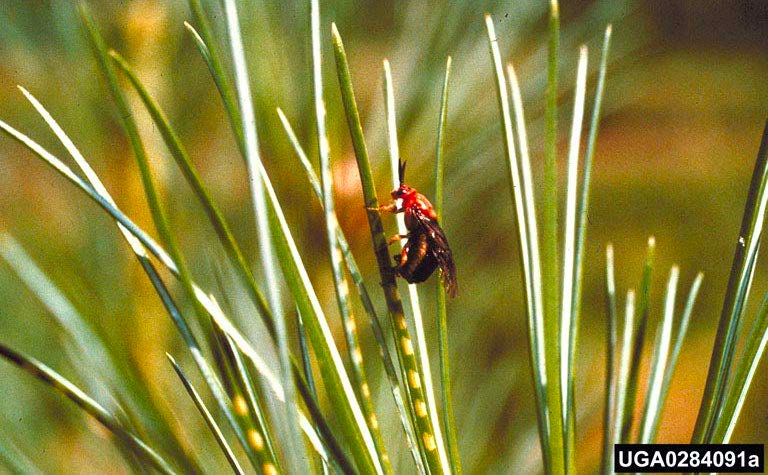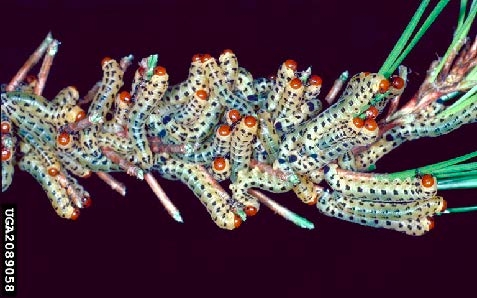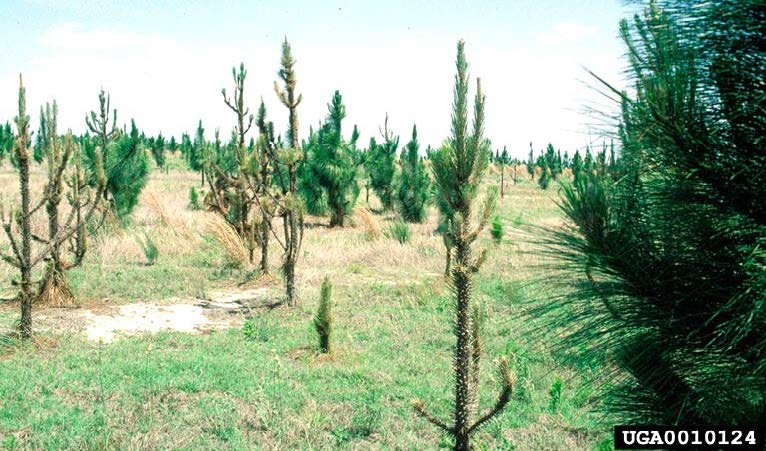Redheaded Sawfly
ID
3006-1453 (ENTO-429NP)
Introduction
Redheaded sawfly, Neodiprion lecontei (Fitch), belongs to the family Diprionidae in the order Hymenoptera.
Description
Adult sawflies look similar to true flies, but have two pairs of wings instead of one pair. Adult females are larger (6-9.5 mm in length) than males (5-6.5 mm). Females have a red head and thorax, with black wings and a lighter-colored abdomen. Males are darker in color, with broad, feathery antennae.

Females lay individual oval eggs (0.5 mm long) in a row of slits cut into the edge of the needles, which produces light-colored discolorations on the needle (Fig. 1). All eggs laid by a female are generally grouped on the needles of a single twig.
Sawfly larvae resemble caterpillars, but have at least six pairs of stubby prolegs behind the three pairs of true legs. In contrast, caterpillars never have more than five pairs of prolegs. Larvae emerge from eggs 2-5 mm long. After feeding, the larval body develops black spots and the head turns reddish- orange (Fig. 2). In the fourth and fifth instars, black spots surround the eyes and the body is a deep-yellow color. Mature larvae drop to the leaf litter and spin cocoons in which they overwinter and pupate. The cocoons are reddish-brown, cylindrical with rounded ends, and measure 10 mm long for females and 7.5 mm long for males.

Life History
In Virginia, there are 2 or 3 generations of redheaded pine sawfly each year. They overwinter in the prepupal stage in cocoons in the soil litter under infested trees. Pupation occurs soon after the onset of warm spring weather, and adults emerge in a few weeks. Eggs deposited in needles hatch in 3-5 weeks. Larvae feed gregariously on both new and old needles and also on the tender bark of young twigs. If not defoliated, damaged needles are tan, twisted, and straw-like. Larvae begin spinning cocoons from late June into early July. Second generation adults emerge in July and August. Second generation larvae feed through September and then spin their cocoons. In warmer areas, adults may emerge at the end of September into late October and lay eggs for a third generation that remains active into December
Damage
The redheaded pine sawfly is the most widespread and destructive of the pine sawflies and is considered an important pest of ornamental, forest, and especially plantation trees. It usually feeds on young trees, preferably 0.3-4.6 m tall. Trees growing under stress in shallow soils, very wet or dry sites, or under stress from competing vegetation are especially susceptible to infestation and heavy defoliation. Outbreaks occur periodically and tend to subside after a few years of heavy defoliation. Severe outbreaks have resulted in the death or deformity of young pines.

Distribution and Hosts
The redheaded pine sawfly occurs from southeastern Canada throughout the eastern US. Feeding is primarily restricted to the two- and three-needled pines, such as Jack, red, shortleaf, loblolly, slash, longleaf, and pitch pines. White pine and Norway spruce may also be defoliated.
Cultural Control
Silvicultural practices recommended for preventing redheaded pine sawfly outbreaks include removing competing vegetation before planting pines and promoting early closure of pines to prevent competing vegetation such as weeds or hardwood species. Avoid planting pines in high hazard areas such as frost pockets, or on excessively dry, wet, or nutrient deficient soils.
Organic/Biological Control
Numerous natural control agents play important roles in reducing redheaded pine sawfly populations. Outbreaks often collapse due to rodents feeding on the pupae and outbreaks of diseases that kill the larvae. Of the 58 species of parasitic and predatory insects affecting this pest, the native egg parasite Closterocerus cinctipennis Ashmead (Hymenoptera) and the larval parasite Spathimeigenia spp. (Diptera) are the most important.
Chemical Control
For ornamental plantings and Christmas trees, the best approach is to apply spot sprays with a registered insecticide where and when new colonies of redheaded pine sawfly are found. Treat with a registered insecticide following recommendations found in the current Horticulture and Forest Crops Pest Management Guide (VCE Publication 456-017) for commercial plantings, or in the Home Grounds and Animals Pest Management Guide (VCE Publication 456-018) for home owners. This insect tends to be sporadic in location and can occur from May to September. As with all pesticides, follow the label instructions carefully with regards to rates and precautions.
References
Benjamin, D.M. 1955. The biology and ecology of the redheaded pine sawfly. USDA For. Serv. Tech. Bull. No. 1118. 57 pp.
Drooz, A.T. 1985. Insects of Eastern Forests. USDA For. Serv. Misc. Publ. #1426. 608 pp.
Revised
Theresa A. Dellinger, January 25, 2021.
Virginia Cooperative Extension materials are available for public use, reprint, or citation without further permission, provided the use includes credit to the author and to Virginia Cooperative Extension, Virginia Tech, and Virginia State University.
Virginia Cooperative Extension is a partnership of Virginia Tech, Virginia State University, the U.S. Department of Agriculture (USDA), and local governments, and is an equal opportunity employer. For the full non-discrimination statement, please visit ext.vt.edu/accessibility.
Publication Date
March 5, 2021



